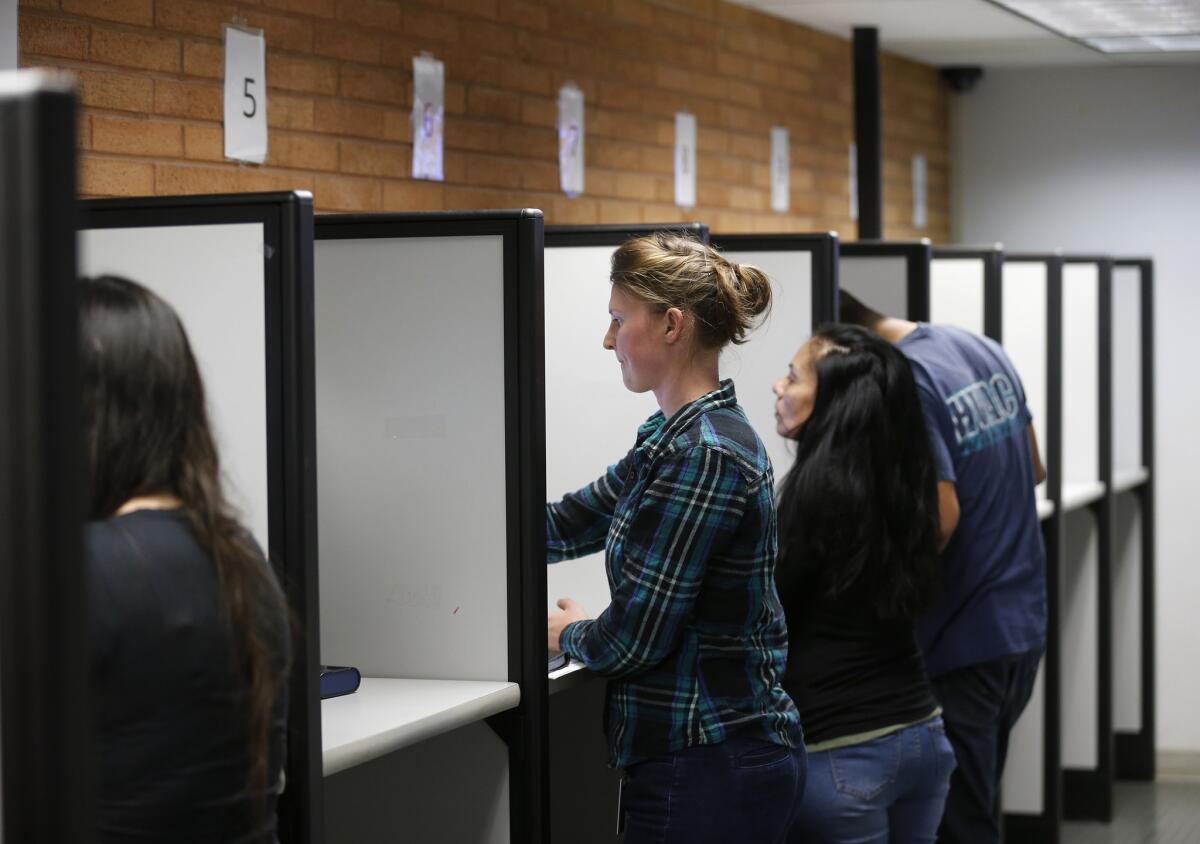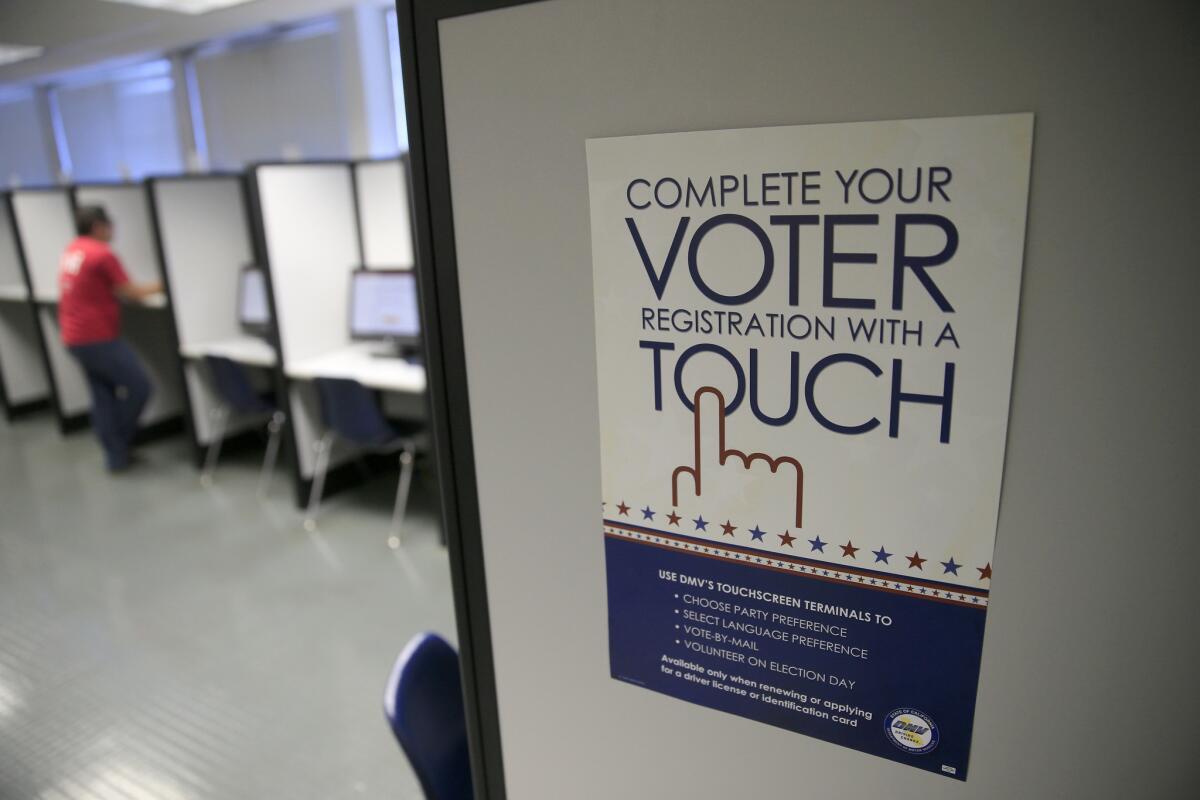Registered to vote at the DMV? Check again. Many who use the new process miss a vital step two

- Share via
If you’ve visited the DMV in the last few weeks, you may have noticed that you can now complete your voter registration at the same time you renew your driver’s license — without having to fill out a separate form.
But it’s a little more complicated than that.
Unless voters also stop to answer questions at a computer terminal in another room, they will be registered as having no party preference. Voter advocates say this two-step process could disenfranchise thousands of voters, especially those who still want to vote in the Republican Party’s closed presidential primary.
Since the terminals were rolled out April 1, the Department of Motor Vehicles has registered more than 14,000 voters in its offices statewide. Of those, 4,747 people — more than one-third — did not complete questions posed at the touch screens.
The machines, located in a separate room and typically used to administer written driver’s tests, now ask several optional questions, including language preference, if a person wants to be a permanent vote-by-mail voter and party preference.
“We really think people are going to slip through the cracks here,” says Lori Shellenberger, voting rights director for the ACLU of California, which last year threatened to sue the DMV over voter registration issues.
The DMV says the new system improves upon the largely paper-based one it previously used and is a major step toward the eventual implementation of the state’s new motor voter law, which is expected to add millions of Californians to the voter rolls. In an email sent after this article was originally published, DMV spokeswoman Jessica Gonzalez disputed the way voter advocates had characterized their new system, saying the agency doesn’t view it as a “two-step” process.
But voting rights activists say there’s more work to be done.
Secretary of State Alex Padilla, the state’s top elections official, did not respond to specific questions about the issues the advocates raised. He stressed in a statement that he is concerned when anyone finds it cumbersome to register to vote. “We should work with advocates and simplify the process,” he said.
Registrars say the DMV does not have the smoothest system.
“I used to tell voters, ‘You don’t come to me to register your car, so don’t go to the DMV to register to vote,’ ” says Gail Pellerin, the registrar for Santa Cruz County. She has been critical of the agency’s protocols in the past.
When the National Voter Registration Act was passed in 1993, it required state DMVs to register citizens to vote. Then-Gov. Pete Wilson refused to implement the law, calling it “another unfunded federal mandate.” Along with several other governors, he sued to block it and lost.

Since then, California’s driver’s license application has asked whether citizens want to register to vote or change their registration. Until last month, answering “yes” meant having to fill out a separate voter registration card stapled to the back of the application – with much of the same information already listed on the driver’s license form.
DMV employees had to ship completed forms to the secretary of State for data entry. For years, voting rights activists argued the process was too cumbersome and violated the law.
“They did the minimum they had to, and it wasn’t enough,” said Shellenberger. “Every election... we got countless calls from people” who thought they’d registered to vote at the DMV but didn’t show up in the database when they showed up to vote.
Kathryn Swartz-Rees, a recent transplant from Chicago, says it took her nearly three months to get registered after she visited a DMV office in January. The clerk there didn’t mention anything about registering to vote, Swartz-Rees said, but she filled out a form anyway.
After checking on her registration repeatedly for six weeks, she called the L.A. County registrar, where an employee seemed unsurprised that her DMV registration hadn’t gone through. “It just seemed like… this was not an uncommon thing to hear, that either this paper application disappeared or didn’t get filed,” Swartz-Rees said. She finally registered to vote online instead.
Last year, a coalition of groups including the ACLU and League of Women Voters sent a letter to the DMV, threatening to sue if the agency didn’t come up with a more streamlined process.
------------
For the Record
May 10, 2:54 p.m.: This post has been updated to clarify that the DMV and the Secretary of State jointly requested and were granted $2.3 million to upgrade voter registration systems, including incorporating the signature pads. An earlier version of this post erroneously stated that a Senate budget committee approved the DMV’s request for $3.9 million last week.
------------
The DMV and Secretary of State’s office asked for and were granted $2.3 million to incorporate signature pads already at counters so citizens could complete their voter registration with one transaction.
At about the same time, the New Motor Voter Act was winding its way through the Legislature and was ultimately signed by Gov. Jerry Brown. The law requires the DMV to automate voter registration by electronically transmitting drivers’ data to the secretary of State unless the person opts out.
Anticipating a surge in voters registering in field offices, DMV officials quickly pivoted from their plan to use the signature pads to instead use more plentiful touch-screen terminals.
“We were nimble and responsive and were able to identify a solution … without negatively impacting our DMV customers,” DMV Director Jean Shiomoto said at a legislative hearing last week, adding that each DMV field office has only one or two signature pads. “We were mindful not to have customers waiting in long lines.”
Voter advocates and local election officials say they’ve seen the DMV turn a corner in its commitment to the voter registration mission.
“They just had to get the democracy bug,” Pellerin says. “It seems like we’re all working together more now than, let’s say, four years ago.”
Pellerin and other county registrars have applauded the DMV for its recent initiatives, including rigging its online driver’s license renewal system to automatically enter a driver’s data into the secretary of State’s online voter registration system if the person indicates her or she wants to register to vote.
Results from that effort, launched March 30, already have had an impact: More than 12,970 voters have been registered through this portal as of April 28, compared with 915 voters who followed a simple link on the DMV’s website the month before.
SIGN UP for our free Essential Politics newsletter >>
But Shellenberger and other voter advocates say the fact that early data show so many people are walking out of DMV offices without going to the touch-screen machines is a “glaring problem” that should be fixed before the New Motor Voter law is implemented in July 2017.
Shiomoto told lawmakers at the hearing that her agency is open to making adjustments, and has already added “employee ambassadors” at each field office. They are tasked with shepherding people to the touch-screen terminals to complete the voter registration process. Bright pink slips of paper printed with a “checklist” are supposed to help guide them, too.
For voters who leave the DMV office without completing the touch-screen questions, the secretary of State plans to send follow-up letters, instructing the voter to register all over again — either online or by filling out a paper form. But because the voters’ language preferences are not known, the letter that will hit mailboxes will be in 10 languages, including Spanish, Hindi, Korean and Khmer. That makes the letter more likely to be ignored, activists say.
The DMV has asked lawmakers for another $3.9 million to continue implementing the New Motor Voter Act. After voter advocates and elections officials sent letters raising their concerns, an Assembly budget committee voted 3 to 2 last week to approve the request but also added language requiring the DMV to implement a “one-step” voter registration process by next year. It remains unclear whether that language will be adopted as part of the final budget this June.
In the meantime, many elections officials say they are advising voters who registered at the DMV to double-check, or to just register online ahead of the June 7 primary. The deadline to register is May 23.
Voting rights activists say they will continue to press for a seamless process.
“It has felt like the system is trying to fit a square peg into a round hole,” Shellenberger testified at the hearing last week. “At some point, something may have to give.”
For more on California politics, follow @cmaiduc.
ALSO:
California elections officials warn of ‘surge’ for June 7 primary
Q&A: How California’s new voter registration law will work
Are you an independent voter? You aren’t if you checked this box
How California’s U.S. Senate ballot could cause problems for the June 7 primary
UPDATES
4:36 p.m.: This article has been updated with a comment from DMV spokeswoman Jessica Gonzalez.
This article was originally published at 12:05 a.m.
More to Read
Get the L.A. Times Politics newsletter
Deeply reported insights into legislation, politics and policy from Sacramento, Washington and beyond. In your inbox three times per week.
You may occasionally receive promotional content from the Los Angeles Times.











